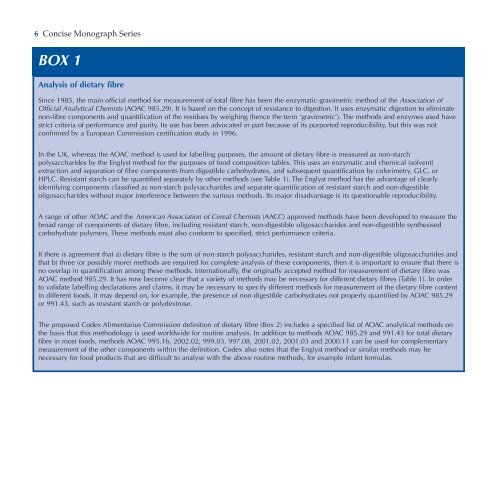Dietary Fibre - ILSI Argentina
Dietary Fibre - ILSI Argentina
Dietary Fibre - ILSI Argentina
Create successful ePaper yourself
Turn your PDF publications into a flip-book with our unique Google optimized e-Paper software.
6 Concise Monograph Series<br />
BOX 1<br />
Analysis of dietary fibre<br />
Since 1985, the main official method for measurement of total fibre has been the enzymatic-gravimetric method of the Association of<br />
Official Analytical Chemists (AOAC 985.29). It is based on the concept of resistance to digestion. It uses enzymatic digestion to eliminate<br />
non-fibre components and quantification of the residues by weighing (hence the term ‘gravimetric’). The methods and enzymes used have<br />
strict criteria of performance and purity. Its use has been advocated in part because of its purported reproducibility, but this was not<br />
confirmed by a European Commission certification study in 1996.<br />
In the UK, whereas the AOAC method is used for labelling purposes, the amount of dietary fibre is measured as non-starch<br />
polysaccharides by the Englyst method for the purposes of food composition tables. This uses an enzymatic and chemical (solvent)<br />
extraction and separation of fibre components from digestible carbohydrates, and subsequent quantification by colorimetry, GLC, or<br />
HPLC. Resistant starch can be quantified separately by other methods (see Table 1). The Englyst method has the advantage of clearly<br />
identifying components classified as non-starch polysaccharides and separate quantification of resistant starch and non-digestible<br />
oligosaccharides without major interference between the various methods. Its major disadvantage is its questionable reproducibility.<br />
A range of other AOAC and the American Association of Cereal Chemists (AACC) approved methods have been developed to measure the<br />
broad range of components of dietary fibre, including resistant starch, non-digestible oligosaccharides and non-digestible synthesised<br />
carbohydrate polymers. These methods must also conform to specified, strict performance criteria.<br />
If there is agreement that a) dietary fibre is the sum of non-starch polysaccharides, resistant starch and non-digestible oligosaccharides and<br />
that b) three (or possibly more) methods are required for complete analysis of these components, then it is important to ensure that there is<br />
no overlap in quantification among these methods. Internationally, the originally accepted method for measurement of dietary fibre was<br />
AOAC method 985.29. It has now become clear that a variety of methods may be necessary for different dietary fibres (Table 1). In order<br />
to validate labelling declarations and claims, it may be necessary to specify different methods for measurement of the dietary fibre content<br />
in different foods. It may depend on, for example, the presence of non-digestible carbohydrates not properly quantified by AOAC 985.29<br />
or 991.43, such as resistant starch or polydextrose.<br />
The proposed Codex Alimentarius Commission definition of dietary fibre (Box 2) includes a specified list of AOAC analytical methods on<br />
the basis that this methodology is used worldwide for routine analysis. In addition to methods AOAC 985.29 and 991.43 for total dietary<br />
fibre in most foods, methods AOAC 995.16, 2002.02, 999.03, 997.08, 2001.02, 2001.03 and 2000.11 can be used for complementary<br />
measurement of the other components within the definition. Codex also notes that the Englyst method or similar methods may be<br />
necessary for food products that are difficult to analyse with the above routine methods, for example infant formulas.

















